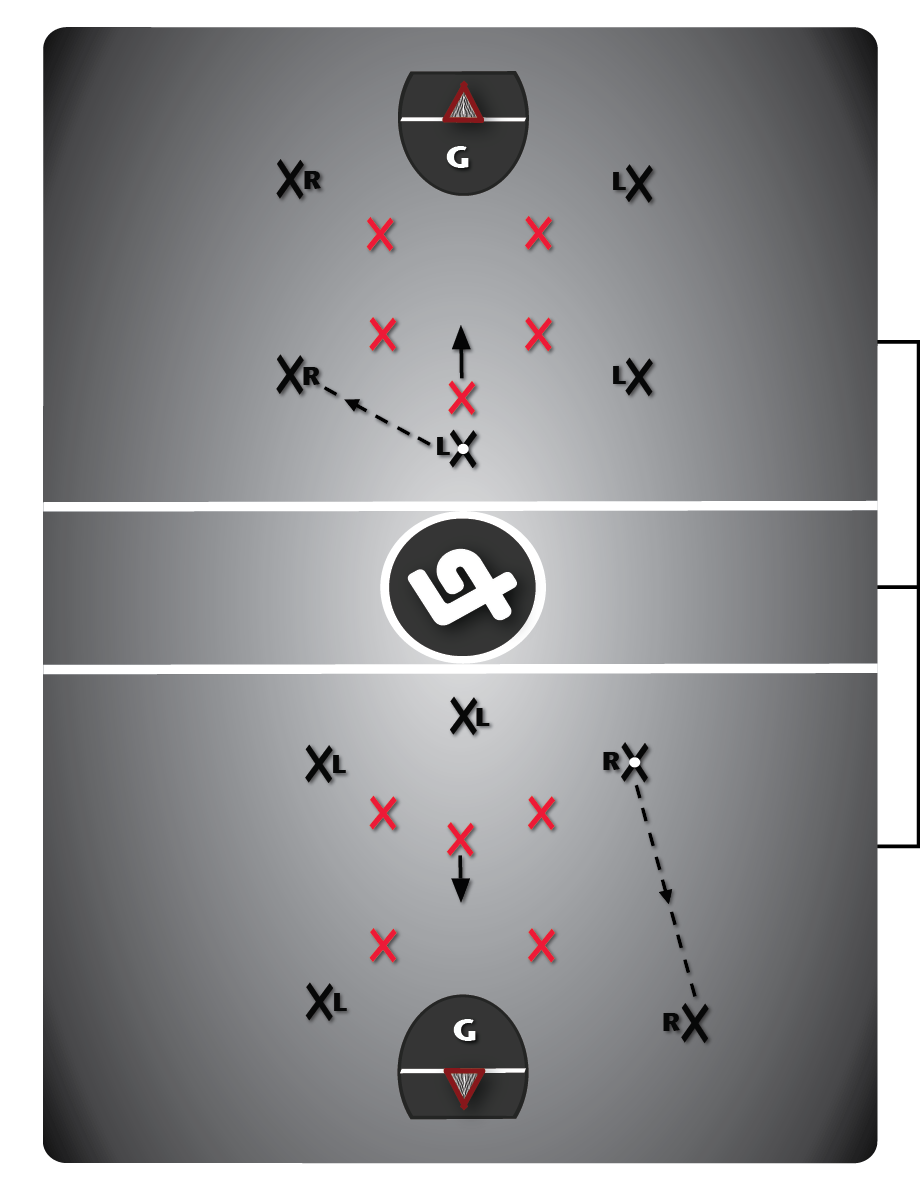
Basic “House” Defense
- Zone Defense: A style of defense characterized by defensive players covering a certain area of the floor.
- A basic "house" zone defense is essentially the inverted coverage of the prime scoring area, in the shape of a stick-figured house (box + triangle).
- Two defenders cover the crease positions, two cover the shooter positions and one covers the point position. The defensive zone can effectively be broken into 4 quadrants, with each of the low (crease) and high (shooter) defenders responsible for what happens in their quadrants.
- Generally, you want bigger defenders low; players who are willing to block shots, box-out in front of the net and ideally someone with good stick skills able to pick off passes going through to the crease. Up high, you want your quicker, smarter defenders, able to make split second decisions like closing the gap on shooters, getting on the gloves of passers and pursuing loose balls.
- The most important player in the defense is the point defender, who is usually the smartest player on the floor on any given shift; with their first responsibility being to make sure that all of their teammates are in their respective positions.
- The defender covering the point must “play on a string,” covering both the point player and the middle of the box when the point player doesn’t have the ball. While in the middle, this player must be prepared to help any teammate that gets beat; adjacent defenders should also "show help" as best as possible, without over-committing.
- Once all defenders have established their spot in the zone they should: keep their sticks up (in passing lanes), maintain "top-side" positioning (closed stance) and stand in shooting lanes on-ball. The high defenders are responsible for closing the gap on shooters and fighting overtop of seals, while the on-ball low defenders responsibility is mainly to block shots and not get beat underneath (where they have no help). It's also worth noting the the low defenders should be as low as the other teams lowest offensive player on their side, as a general rule.
- Off-ball defenders should be in line with the far-side goal post, in an open stance, defending against back-door passes, with cutters being followed and "passed off" once they exit out of a player's designated area (communicated amongst one another). The low defender off-ball only has one job and that's to lock off the crease, not allowing any passes to get through.
- If at any time an opponent enters the area that a player is covering, they should be cross-checked, clamped, or perhaps slashed if they have the ball. Teammates also need to communicate and "pass off" when an opponent exits their zone. Collectively, off-ball defenders should sag, "stay tight" and be prepared to help any teammate that gets beat toward the net (adjacent or off-ball), leaving their check entirely and sliding over, where required. There is no need to chase one's check out by the boards as ultimately they will need to come to the middle and get to the net to be a scoring threat.
- Beginner/intermediate lacrosse teams should have players start in this defensive formation, time permitting. If players are unable to run to their designated area by the time the ball has entered the defensive zone, due to a fast break by the opponent for example, sometimes it's best for the coach or an aware defender to call off this defense and switch to a "man" defense, aka Helping Player-on-Player Defense, for that particular shift.
- Note: This system is generally the default defense used to defend a 6-on-5 (“pull the goalie”) situation. It is also worth noting that the best way to beat a zone defense is to overload one area of the zone with 2 players, which is why all defenders need to be ready to fight overtop of any seals in their zone and give help to any teammates that they see getting overloaded.

Would you like to share your thoughts?
Your email address will not be published. Required fields are marked *
Leave a Reply
You must be logged in to post a comment.
Would you like to share your thoughts?
Your email address will not be published. Required fields are marked *
Leave a Reply
You must be logged in to post a comment.
0 Comments